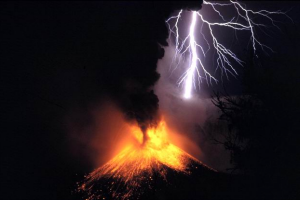 Most preppers probably don’t spend very much time getting ready for a supervolcano like Yellowstone to erupt. Or at least they don’t if they’ve done their research. While there are a handful of these volcanoes on Earth, each of which could devastate our planet’s environment for years, the time between each eruption can be measured in hundreds of thousands of years. In all likelihood, we’re not going to see one of these volcanoes erupt in our lifetimes.
Most preppers probably don’t spend very much time getting ready for a supervolcano like Yellowstone to erupt. Or at least they don’t if they’ve done their research. While there are a handful of these volcanoes on Earth, each of which could devastate our planet’s environment for years, the time between each eruption can be measured in hundreds of thousands of years. In all likelihood, we’re not going to see one of these volcanoes erupt in our lifetimes.
On the other hand, supervolcanoes are still pretty scary, because they can erupt at anytime. They’re kind of like those old jack-in-the-box toys. They spend a lot of time building up pressure before unexpectedly blowing up in your face.
Which has to make you wonder, how much warning would the public get before one of these geological beasts blows up? Even if a supervolcano is overdue for an eruption, that could mean that it’s going to blow its top tomorrow or 10,000 years from now. Is it really just going to go off one day without any warning, or will there be signs that will tip us off ahead of time?
It turns out that yes, supervolcanoes would provide a few warning signs that would give us a fairly definite timeline before they go off, but unfortunately it’s not a very comforting timeline. According to a recent study, you’d have about a year or less to prepare.
Right before any super eruption though, there is one final stage — the decompression stage — characterized by the release of gas bubbles at the eruption site.
So, the study researchers decided to analyze quartz crystals at the site of one of these massive eruptions that erupted in California about 760,000 years ago, creating the Long Valley Caldera. Quartz crystals cover surface rims of eruption sites, so by analyzing them, the researchers were able to determine the rim growth rates times of the volcano based on the concentration of titanium in the crystals. By measuring the size and growth rates of these rims, they were able to determine the length of time it took for an explosion to happen once the decompression phase had begun.
Their analysis showed that more than 70% of rim growth occurred in less than a year, indicating that the quartz rims grow mostly in just the days or months prior to an eruption.
At first glance, most preppers would find that kind of warning to be a relief. After all, if someone told you that say, a nuclear war was going to happen in a year or that a tsunami was going to wipe out your home in a few months, you would have plenty of time to either get ready or get out of dodge.
But with a supervolcano, you’re dealing with a disaster that people and governments would need more time to prepare for. Depending on where the volcano is positioned, millions of people may need to be evacuated, which even with a year’s heads up could turn into a massive humanitarian disaster.
And then there’s the ash that would spew over an area that could be as large as nearly 200,000 square miles, and piled several inches deep on the ground after it settles, screwing up crops and clogging rivers and streams in the process.
And finally, the volcano could expel massive amounts of gasses like sulfur dioxide, which would reflect the sun’s rays away from the Earth. That would likely cause unusual rain patterns and freezing weather, in regions and seasons that wouldn’t normally have those conditions. There’s no doubt that we’d be faced with massive crop failures all over the world. And if that’s not bad enough, this scenario could play out over the course of a decade.
There are already hundreds of millions of people who don’t have food. There’s no telling how many of them would die within a decade, or how much geopolitical insecurity that could cause. When you think about it, a supervolcano could totally shatter the current world order, for better or for worse, and that’s not really something any person or government could prepare for in less than a year.
